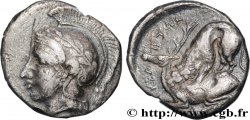v53_0012 - LUCANIA - VELIA Nomos ou statère
MONNAIES 53 (2012)
Prezzo di inizio : 480.00 €
Valutazione : 750.00 €
Prezzo realizzato : 612.00 €
Numero di offerte : 2
Offerta maxima : 1 799.00 €
Prezzo di inizio : 480.00 €
Valutazione : 750.00 €
Prezzo realizzato : 612.00 €
Numero di offerte : 2
Offerta maxima : 1 799.00 €
Tipo : Nomos ou statère
Data: c. 340-334 AC.
Nome della officina / città: Lucanie, Vélia
Metallo : argento
Diametro : 21,50 mm
Asse di coniazione : 6 h.
Peso : 7,19 g.
Grado di rarità : R2
Emission: 53e
Commenti sullo stato di conservazione:
Exemplaire sur un flan large bien centré des deux côtés. Beau portrait de bonne facture et de joli style. Revers bien venu à la frappe avec un lion à l’usure régulière. Une jolie patine gris foncé recouvre l’exemplaire avec des reflets dorés et bleutés
N° nelle opere di riferimento :
Pedigree :
Cet exemplaire provient du stock d’Alain Weil (novembre 1999) et de la collection D. C
Diritto
Titolatura diritto : ANÉPIGRAPHE.
Descrittivo diritto : Tête d'Athéna à droite, coiffée du casque attique à cimier avec triple aigrette, orné d’un griffon.
Legenda diritto : (CA)
Rovescio
Descrittivo rovescio : Lion passant à droite.
Legenda rovescio : UELHTWN/ E/ Q
Traduzione rovescio : (de Vélia).
Commento
Poids léger. Mêmes coins que l’exemplaire de l’American Numismatic Society (ANS. 1305, pl. 35) que l’exemplaire de la collection Lockett (SNG. Lockett, n° 550, pl. X) et que les exemplaires de l’Ashmolean Museum d’Oxford (SNG. Oxford, n° 1207 et 1208, pl. XX). Très tôt, le monnayage de Vélia a été décrit comme ayant inspiré la drachme lourde de Marseille (LT. 785-791). Certains l’ont même décrit comme un monnayage symmachique : un lion de Vélia étant l’équivalent de deux lions de Marseille. Aujourd’hui, cette théorie est remise en cause par G. Depeyrot, non sans arguments, mais avec une certaine acrimonie. Le lion de Vélia a pu servir de modèle à celui de Marseille, mais à quelle date ? La frappe à Vélia commence dans la seconde moitié du Ve siècle avant J.-C. pour se poursuivre jusqu’en 281 avant J.-C. À quel moment les Massaliotes auraient-ils empruntés le lion de Vélia ?.
Light weight. Same dies as the American Numismatic Society copy (ANS. 1305, pl. 35), the copy in the Lockett collection (SNG. Lockett, no. 550, pl. X), and the examples in the Ashmolean Museum, Oxford (SNG. Oxford, nos. 1207 and 1208, pl. XX). Very early on, the coinage of Velia was described as having inspired the heavy drachma of Marseille (LT. 785-791). Some have even described it as a symmachic coinage: one lion of Velia being the equivalent of two lions of Marseille. Today, this theory is challenged by G. Depeyrot, not without argument, but with some acrimony. The lion of Velia may have served as a model for that of Marseille, but at what date? Minting at Velia began in the second half of the 5th century BC and continued until 281 BC. When did the Massaliotes borrow the lion of Velia?
Light weight. Same dies as the American Numismatic Society copy (ANS. 1305, pl. 35), the copy in the Lockett collection (SNG. Lockett, no. 550, pl. X), and the examples in the Ashmolean Museum, Oxford (SNG. Oxford, nos. 1207 and 1208, pl. XX). Very early on, the coinage of Velia was described as having inspired the heavy drachma of Marseille (LT. 785-791). Some have even described it as a symmachic coinage: one lion of Velia being the equivalent of two lions of Marseille. Today, this theory is challenged by G. Depeyrot, not without argument, but with some acrimony. The lion of Velia may have served as a model for that of Marseille, but at what date? Minting at Velia began in the second half of the 5th century BC and continued until 281 BC. When did the Massaliotes borrow the lion of Velia?








 Segnalare un errore
Segnalare un errore Stampate la pagina
Stampate la pagina Condividi mia selezione
Condividi mia selezione Fai una domanda
Fai una domanda Consegnare / vendere
Consegnare / vendere
 Descrittivo
Descrittivo









